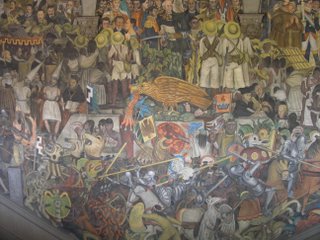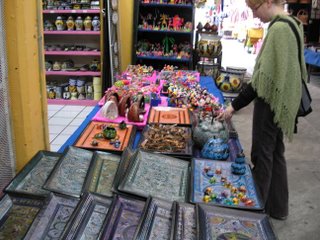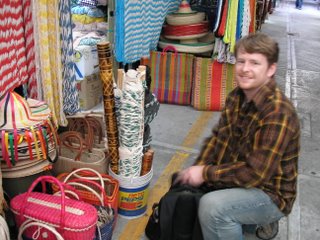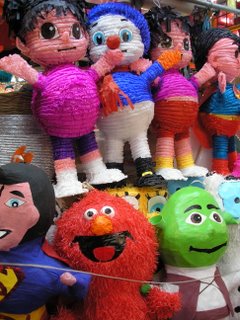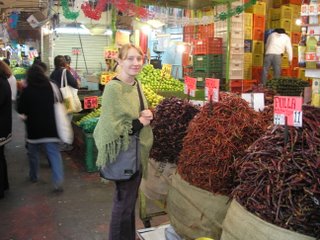 During our trip to Mexico, Karen and I were determined to try anything and everything that Mexico's cuisine had to offer. Our adventure began in El Mercado Merced in downtown Mexico City. This place is the size of several Wal-Marts strung together, spanning more than a few city blocks. At Merced, you can buy virtually anything you want, and the space is divided up so that there are acres of spices in one spot, large expanses of nopales cactus paddles, and chickens hanging upside down as far as the eye can see. The sweets above were really intriguing. We decided on a few of the hockey-puck shaped macaroons (that's them in the middle with the lime leaf attached and also some with an orange sweet potato color). I carried them around in my bag for 10 days and had a nibble whenever I got peckish.
During our trip to Mexico, Karen and I were determined to try anything and everything that Mexico's cuisine had to offer. Our adventure began in El Mercado Merced in downtown Mexico City. This place is the size of several Wal-Marts strung together, spanning more than a few city blocks. At Merced, you can buy virtually anything you want, and the space is divided up so that there are acres of spices in one spot, large expanses of nopales cactus paddles, and chickens hanging upside down as far as the eye can see. The sweets above were really intriguing. We decided on a few of the hockey-puck shaped macaroons (that's them in the middle with the lime leaf attached and also some with an orange sweet potato color). I carried them around in my bag for 10 days and had a nibble whenever I got peckish.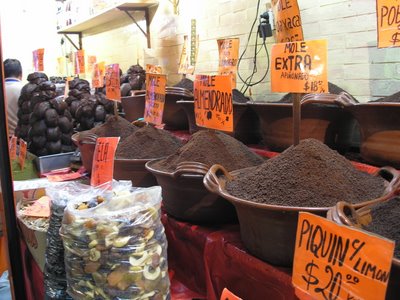 These powders and pastes are sold in bulk to save cooking time for busy Mexicans. The super-complex mole sauces typically contain 40 or more ingredients (usually including chocolate, chilis, and pumkin seeds) and require hours of grinding, pureeing, and simmering. We followed the average person's lead and bought the mole poblano paste (from the city of Puebla) and brought it home. Just add hot stock and oil until it has the right consistency. Mmmmmm, spicy, chocolatey, complexly savory. As they say, "if the sauce is not good, the dish is not good."
These powders and pastes are sold in bulk to save cooking time for busy Mexicans. The super-complex mole sauces typically contain 40 or more ingredients (usually including chocolate, chilis, and pumkin seeds) and require hours of grinding, pureeing, and simmering. We followed the average person's lead and bought the mole poblano paste (from the city of Puebla) and brought it home. Just add hot stock and oil until it has the right consistency. Mmmmmm, spicy, chocolatey, complexly savory. As they say, "if the sauce is not good, the dish is not good."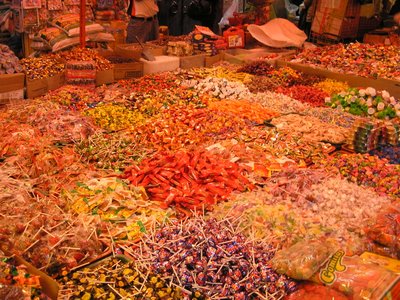 This was such a spread of candy, that I couldn't resist. We didn't eat a lot of dulces (sweets), but they sure have some strange flavors (spicy mango, guanabana). On one road trip, I came out of the convenient store with something called Bubu Lubu. It was a candy-bar that's kept in the refridgerated section. Imagine a layer of marshmallow topped with a layer of artificially flavored cherry gummy-jelly and the whole thing covered in milk chocolate. I didn't like it, but I washed it down with a can of Coke to give myself a familiar queasy feeling (as opposed to the strange and unpredictable stomach rumblings that terrorized our trip).
This was such a spread of candy, that I couldn't resist. We didn't eat a lot of dulces (sweets), but they sure have some strange flavors (spicy mango, guanabana). On one road trip, I came out of the convenient store with something called Bubu Lubu. It was a candy-bar that's kept in the refridgerated section. Imagine a layer of marshmallow topped with a layer of artificially flavored cherry gummy-jelly and the whole thing covered in milk chocolate. I didn't like it, but I washed it down with a can of Coke to give myself a familiar queasy feeling (as opposed to the strange and unpredictable stomach rumblings that terrorized our trip). Eating in Mexico is comparable to eating in Italy (so I'm told). Just like the Olive Garden's pasta isn't real Italian, don't even think you've eaten Mexican food until you've been there. That combination plate that we get served in our local restaurants is laughable and pitiful compared to the fresh and flavorful dishes that make up the staple diet of Mexicans. And also, like Italians, Mexicans use a lot of garlic. This stand must have sold 30 different types. This section of the market really reeked of powerful smelling root vegetables.
Eating in Mexico is comparable to eating in Italy (so I'm told). Just like the Olive Garden's pasta isn't real Italian, don't even think you've eaten Mexican food until you've been there. That combination plate that we get served in our local restaurants is laughable and pitiful compared to the fresh and flavorful dishes that make up the staple diet of Mexicans. And also, like Italians, Mexicans use a lot of garlic. This stand must have sold 30 different types. This section of the market really reeked of powerful smelling root vegetables. Believe it or not, we didn't eat many beans in Mexico. And when we did, they were usually refried black beans served next to the main course. Nonetheless, there are many many kinds of frijoles to be had. Maybe one day, I'll have one of these bean cubbies in my pantry (when I get a house big enough for a pantry).
Believe it or not, we didn't eat many beans in Mexico. And when we did, they were usually refried black beans served next to the main course. Nonetheless, there are many many kinds of frijoles to be had. Maybe one day, I'll have one of these bean cubbies in my pantry (when I get a house big enough for a pantry).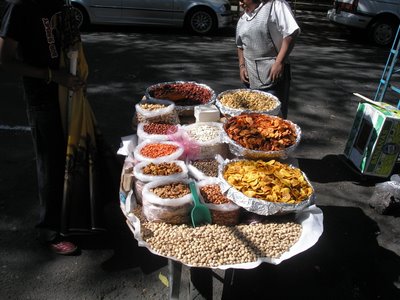 One thing that impressed me were the snacks in Mexico. It really seemed like people just eat all day. Portions are small and prices are cheap and everyone is eating on the go. Potato chips may seem like a trivial part of any culture, but Karen and I were impressed by how superior the potato chips were in Mexico to the Frito-Lays stuff we've got to choose from. The big brandname there is Sabritas (little tasties, if my translation is correct). Their chips are common in every way except for the flamboyantly loud flavors: lime, salsa caliente, tomatoes and garlic. Mmmmmm... Oddly, we will miss those bags of potato chips sorely. I can only imagine that this guy's fresh chips are even better.
One thing that impressed me were the snacks in Mexico. It really seemed like people just eat all day. Portions are small and prices are cheap and everyone is eating on the go. Potato chips may seem like a trivial part of any culture, but Karen and I were impressed by how superior the potato chips were in Mexico to the Frito-Lays stuff we've got to choose from. The big brandname there is Sabritas (little tasties, if my translation is correct). Their chips are common in every way except for the flamboyantly loud flavors: lime, salsa caliente, tomatoes and garlic. Mmmmmm... Oddly, we will miss those bags of potato chips sorely. I can only imagine that this guy's fresh chips are even better. Another snack that is popular in Mexico (only the southern part, I'm told) is huaraches. They're sort of the equivalent of a New York slice: cheap, fast, cheezy, tasty.
Another snack that is popular in Mexico (only the southern part, I'm told) is huaraches. They're sort of the equivalent of a New York slice: cheap, fast, cheezy, tasty.After walking around that market for a couple hours, sorta intimidated (we were the only gringos), and nervous about what would be alright for us to eat, we finally gave in and got a bite at one of the market's many little sit-down eateries. For about a buck, Karen and I split an enormous huarache. It was a freshly made tortilla that was pressed into an oblong shape, fried, and topped with cheese and salsa (although meat was an option). Our server offered us red or green salsa, but unable to decide, I asked for both, and as you can see in the picture, they obliged. Karen liked the green and I liked the red (symbolic of our respective affinities). Although this was only our second day, that one little snack (enough for both of us) remained one of our favorite foods for the rest of the trip.
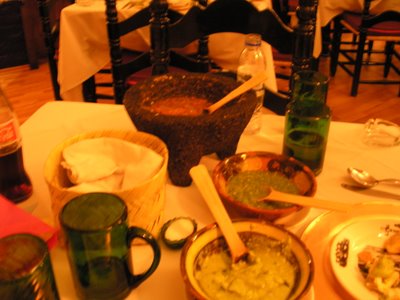 On our first night in Mexico, we walked a couple blocks through La Zona Rosa (the gay district), to a fancy restaurant called La Fonda El Refugio. In a dimly lit dining room, they served expertly crafted traditional Mexican food, fit for royalty. Although we wound up ordering fish in garlic sauce, and three types of enchiladas with mole, and beautiful little quesadillas (that were more like empanadas), our favorite part was the opening round of chips and salsa. We didn't want to use the camera's flash and ruin everyone else's dinner, so please understand why the colors don't quite pop here. But the dishes before you contain guacamole in the foreground (lots of lime juice), salsa verde (tomatillos, garlic, and green chilis), and salsa caliente (with roasted guajillo chilis). This last one only comes out upon special request. Silly me, I told them that I wanted spicy salsa before even trying the green stuff they set down for us. And so, out comes this enormous molcajete filled with smokey salsa. The meal went on brilliantly, but we sorta over did it with the appetizers and had to take some leftovers back to our hotel.
On our first night in Mexico, we walked a couple blocks through La Zona Rosa (the gay district), to a fancy restaurant called La Fonda El Refugio. In a dimly lit dining room, they served expertly crafted traditional Mexican food, fit for royalty. Although we wound up ordering fish in garlic sauce, and three types of enchiladas with mole, and beautiful little quesadillas (that were more like empanadas), our favorite part was the opening round of chips and salsa. We didn't want to use the camera's flash and ruin everyone else's dinner, so please understand why the colors don't quite pop here. But the dishes before you contain guacamole in the foreground (lots of lime juice), salsa verde (tomatillos, garlic, and green chilis), and salsa caliente (with roasted guajillo chilis). This last one only comes out upon special request. Silly me, I told them that I wanted spicy salsa before even trying the green stuff they set down for us. And so, out comes this enormous molcajete filled with smokey salsa. The meal went on brilliantly, but we sorta over did it with the appetizers and had to take some leftovers back to our hotel.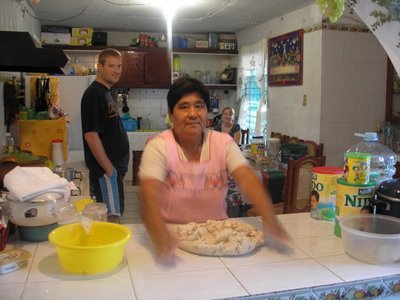 In Veracruz (five hours east of Mexico City), we stayed with my step-brother David. He lives with his wife, Karina, and over 30 of her family members live in the surrounding two or three blocks. Thanks to my emailing ahead about our interests, Karina's mom decided to teach us to make tortillas from scratch and by hand - an art that is slowly going out of style in Mexico. See above as abuelita makes quick work of a pile of masa dough. She has 17 grandchildren and was happy to take care of us as if we were her own. I kept inquiring where the machina (or tortilla press) was hiding, but she laughed my comments off, saying that we don't really need to use the cheating devices (like the one I've got at home!).
In Veracruz (five hours east of Mexico City), we stayed with my step-brother David. He lives with his wife, Karina, and over 30 of her family members live in the surrounding two or three blocks. Thanks to my emailing ahead about our interests, Karina's mom decided to teach us to make tortillas from scratch and by hand - an art that is slowly going out of style in Mexico. See above as abuelita makes quick work of a pile of masa dough. She has 17 grandchildren and was happy to take care of us as if we were her own. I kept inquiring where the machina (or tortilla press) was hiding, but she laughed my comments off, saying that we don't really need to use the cheating devices (like the one I've got at home!).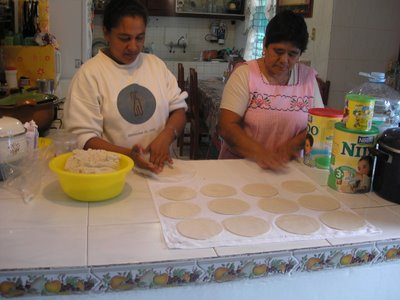 Within minutes, flat discs of masa dough began appearing. Abuelita first formed little balls of dough, which she patted back and forth between her palms until each one was flat and less than a half-inch think. Then, she placed the silver-dollar shaped dough in the center of a circular piece of plastic wrap (or wax paper, or part of a zip-lock bag, etc). The last part is still like a blur to me. With one hand, she turned the plastic circle, and with the other hand she struck her palm of her hand against the dough at an angle that would help turn the disc. A few times around each disc and it became very thin, perfectly round, and about 6" across. Mine did not look like this. Soon, the neighbor brought over her tortilla press so that I could join in without making a mess.
Within minutes, flat discs of masa dough began appearing. Abuelita first formed little balls of dough, which she patted back and forth between her palms until each one was flat and less than a half-inch think. Then, she placed the silver-dollar shaped dough in the center of a circular piece of plastic wrap (or wax paper, or part of a zip-lock bag, etc). The last part is still like a blur to me. With one hand, she turned the plastic circle, and with the other hand she struck her palm of her hand against the dough at an angle that would help turn the disc. A few times around each disc and it became very thin, perfectly round, and about 6" across. Mine did not look like this. Soon, the neighbor brought over her tortilla press so that I could join in without making a mess.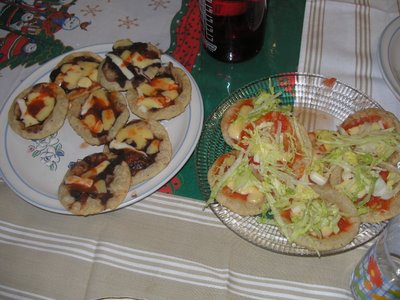 Not long after the tortillas had taken shape, plates of hot food were ready to eat. On the left are gorditas. These tortillas got submerged in boiling oil and they puffed up and became hollow like a pita. A combination of refried black beans, salsa, and cheese went on top. Really tasty! On the right are chalupas. These tortillas were seared on each side on a hot cast-iron tortilla griddle that didn't require any oil. They were topped with more cheese, lettuce, and a sort of salsa fresco or pico de gallo. Two really satisfying snacks that complimented each other well. This was more than enough by our standards, but the food didn't stop rolling out. Earlier that morning, sbuelita woke up ahead of everyone else and prepared a black bean soup with masa dumplings (not pictured, sorry).
Not long after the tortillas had taken shape, plates of hot food were ready to eat. On the left are gorditas. These tortillas got submerged in boiling oil and they puffed up and became hollow like a pita. A combination of refried black beans, salsa, and cheese went on top. Really tasty! On the right are chalupas. These tortillas were seared on each side on a hot cast-iron tortilla griddle that didn't require any oil. They were topped with more cheese, lettuce, and a sort of salsa fresco or pico de gallo. Two really satisfying snacks that complimented each other well. This was more than enough by our standards, but the food didn't stop rolling out. Earlier that morning, sbuelita woke up ahead of everyone else and prepared a black bean soup with masa dumplings (not pictured, sorry).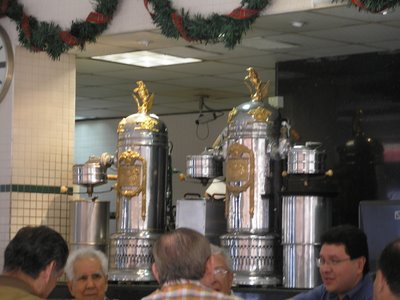 After a couple days imposing on the profound hospitality of my extended Mexican family, Karen and I decided to spend a day walking around downtown Veracruz. One attraction that the guidebooks recommended was Gran Café de la Parroquia on Avenue Insurgentes, a historic coffee shop where artists and political types have gathered for decades to rub elbows, soak up atmosphere, and the unique house coffee drink called "lechero." This beverage of strong coffee and steaming hot milk is alleged to be the original latte. As tasty as it is to drink, what follows after ordering is even more entertaining. The above fancy espresso machines also serve as the logo for the cafe on their bags of coffee, signage, shirts, etc.
After a couple days imposing on the profound hospitality of my extended Mexican family, Karen and I decided to spend a day walking around downtown Veracruz. One attraction that the guidebooks recommended was Gran Café de la Parroquia on Avenue Insurgentes, a historic coffee shop where artists and political types have gathered for decades to rub elbows, soak up atmosphere, and the unique house coffee drink called "lechero." This beverage of strong coffee and steaming hot milk is alleged to be the original latte. As tasty as it is to drink, what follows after ordering is even more entertaining. The above fancy espresso machines also serve as the logo for the cafe on their bags of coffee, signage, shirts, etc.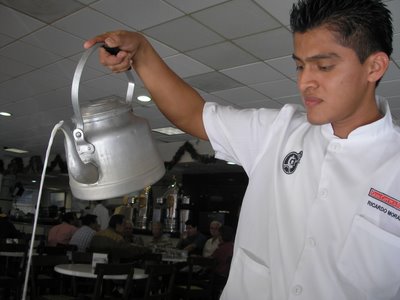 Here's how it works to order a lechero:
Here's how it works to order a lechero:First, the waiter brings out your cup of freshly brewed coffee syrup. Then he taps the side of your glass with a spoon and looks across the room to make sure that the milk guy has heard the call. Then, the milk guy (above) shows up with his kettle and starts pouring from a low height, slowly working his way up to an absurd distance from the cup before you. As the scalding milk fills your cup, not a drop is spilled and a very thick foam forms on top.
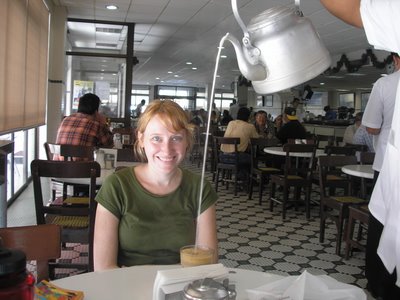 I dunno. What do you think? Was Karen impressed?
I dunno. What do you think? Was Karen impressed?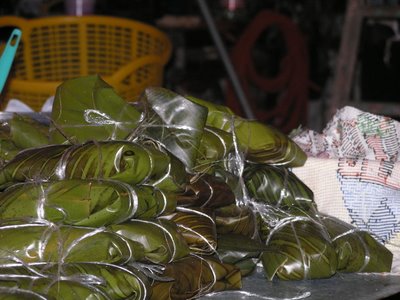 Another common Mexican dish that I wanted to learn to make are tamales (corn meal and savory veggies/meat/beans, wrapped in banana leaves or corn husks, and steamed). However, on our last night in Veracruz we came back to the homestead and found a big production unfolding all around us. The whole neighborhood was alive with anticipation for an evening of celebration in honor of the Virgin de Guadalupe. Because the next day was the anniversary of the Virgin Mary's alleged visit to Mexico, basically everyone in the country was partying, praying, singing, and sharing food. Our hosts spent the day making over 100 tamales, and these above were ready to eat when we arrived at sunset. Our first and only authentic Mexican tamales were filled with chicken and herbs and wrapped in fresh banana leaves. We spent the evening walking back and forth between the house and the church, giving out food, tasting a spicy beer called michelada, sipping Cuban rum, listening to neighborhood folksongs, and the night just kinda fades into a blur if you can imagine.
Another common Mexican dish that I wanted to learn to make are tamales (corn meal and savory veggies/meat/beans, wrapped in banana leaves or corn husks, and steamed). However, on our last night in Veracruz we came back to the homestead and found a big production unfolding all around us. The whole neighborhood was alive with anticipation for an evening of celebration in honor of the Virgin de Guadalupe. Because the next day was the anniversary of the Virgin Mary's alleged visit to Mexico, basically everyone in the country was partying, praying, singing, and sharing food. Our hosts spent the day making over 100 tamales, and these above were ready to eat when we arrived at sunset. Our first and only authentic Mexican tamales were filled with chicken and herbs and wrapped in fresh banana leaves. We spent the evening walking back and forth between the house and the church, giving out food, tasting a spicy beer called michelada, sipping Cuban rum, listening to neighborhood folksongs, and the night just kinda fades into a blur if you can imagine.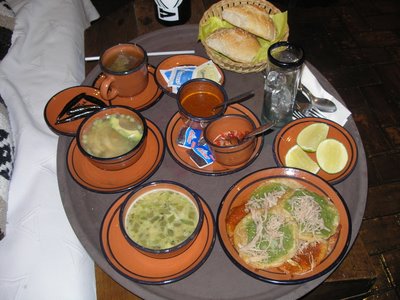 If the last night in Veracruz was a high point (and it was), then the following morning was a low point. We both woke up with serious digestive turmoil. It was all we could do to climb into the car for a ride to the bus-station. Luckily, our next stop was the beautiful city of Puebla (three hours west of Veracruz). Since Karen was in worse shape than I, my first task was a trip to the pharmacy for something called Treda (but we subsequently referred to them as magic pills) to address our digestive problems. After that, I ordered room service from the legendary kitchen of the Meson Sacristia. We each had bowls of soup and cups of tea to help us recover. Somehow, I managed to work on some spicy chalupas. After all, we were in the city that is called the gastronomic capital of Mexico and our hotel has been deemed the city's best restaurant by the New York Times. Those green things on the right, are limes, by the way. Lime slices come with all Mexican food. Seriously, people squeeze limes on everything. If you can explain this to me, please leave a comment.
If the last night in Veracruz was a high point (and it was), then the following morning was a low point. We both woke up with serious digestive turmoil. It was all we could do to climb into the car for a ride to the bus-station. Luckily, our next stop was the beautiful city of Puebla (three hours west of Veracruz). Since Karen was in worse shape than I, my first task was a trip to the pharmacy for something called Treda (but we subsequently referred to them as magic pills) to address our digestive problems. After that, I ordered room service from the legendary kitchen of the Meson Sacristia. We each had bowls of soup and cups of tea to help us recover. Somehow, I managed to work on some spicy chalupas. After all, we were in the city that is called the gastronomic capital of Mexico and our hotel has been deemed the city's best restaurant by the New York Times. Those green things on the right, are limes, by the way. Lime slices come with all Mexican food. Seriously, people squeeze limes on everything. If you can explain this to me, please leave a comment.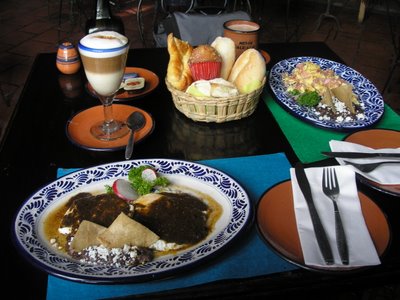 In the morning, we resolved to get back to chowing down. Our first breakfast was awesome. Karen had some kind of eggs and ham scramble, while I had fried eggs topped with the house quick mole (see recipe below). I loved it. The sauce was sour, spicy, and smoky. That two-tone coffee drink was really nice too. But the best part for me followed the meal... see below.
In the morning, we resolved to get back to chowing down. Our first breakfast was awesome. Karen had some kind of eggs and ham scramble, while I had fried eggs topped with the house quick mole (see recipe below). I loved it. The sauce was sour, spicy, and smoky. That two-tone coffee drink was really nice too. But the best part for me followed the meal... see below.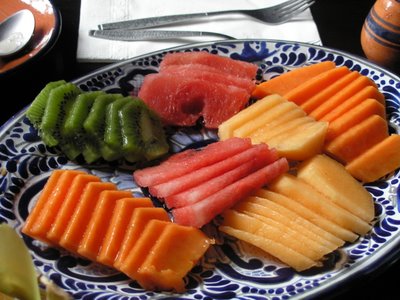 This was my ticket to a functioning digestive system while in Mexico. Every day, I ordered a plate of fresh fruit. Not only was it all sweeter than anything I could get in December back home, but the fiber really helped mediate the conflict that Mexico's spicy chilis and unfamiliar bacteria were causing throughout my body. Karen's insides felt worse than mine, and so she wound up being a fairly cautious eater for the rest of the trip.
This was my ticket to a functioning digestive system while in Mexico. Every day, I ordered a plate of fresh fruit. Not only was it all sweeter than anything I could get in December back home, but the fiber really helped mediate the conflict that Mexico's spicy chilis and unfamiliar bacteria were causing throughout my body. Karen's insides felt worse than mine, and so she wound up being a fairly cautious eater for the rest of the trip. Although we had several great meals at the Meson Sacristia, our best food experience at the hotel was a half-day cooking class with the head chef, Alonso Hernandez. Here he's making guacamole, which may not sound very exciting, but it was to go with a savory meat dish called Tinga Pueblan Stew that made half the class's eyes roll up into their heads. And the real treat of course, the Mole Sacristia was a revelation in sauce-making. Here's the recipe:
Although we had several great meals at the Meson Sacristia, our best food experience at the hotel was a half-day cooking class with the head chef, Alonso Hernandez. Here he's making guacamole, which may not sound very exciting, but it was to go with a savory meat dish called Tinga Pueblan Stew that made half the class's eyes roll up into their heads. And the real treat of course, the Mole Sacristia was a revelation in sauce-making. Here's the recipe:Mole Sacristia
A great use for extra green tomatoes from your garden. Really easy to make. Ask for the meco variety of chipotles at your local latino market. If you can't find them, try whatever dried chilis have a seriously smoky aroma.
6-7 medium green tomatoes
3 Meco chipotle chilis
1-2 large white or yellow onions (quartered)
3-4 cloves of garlic
1 cup water
1/2 cup oil
salt
-roast tomatoes onion and garlic (in the broiler or on the grill until there are plenty of black spots on each
-meanwhile, fry the chilis in a pan coated liberally with oil until they turn golden brown and discard the oil
-put all ingredients in a blender and puree
-heat a 1/4 cup of oil on medium high and then pour the pureed sauce in to scald the ingredients (just a few minutes)
-salt to taste
The sauce will be black. Put it on everything.
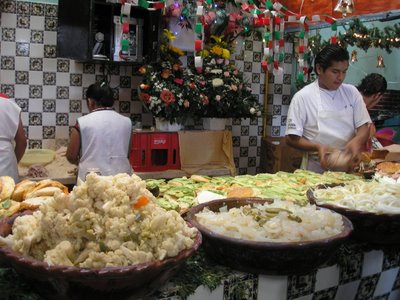 On one of our many walking trips around Puebla, we went to a market where locals go for their produce, chilis, mole paste, illegally copied dvds, and the biggest best sandwich in the whole town. In Pubela, the big sandwich is called a cemita. Many storefronts advertise their cemitas, but this spot leads the pack with their generous piling of ingredients, overwhelming popularity, and impressive assembly-line production.
On one of our many walking trips around Puebla, we went to a market where locals go for their produce, chilis, mole paste, illegally copied dvds, and the biggest best sandwich in the whole town. In Pubela, the big sandwich is called a cemita. Many storefronts advertise their cemitas, but this spot leads the pack with their generous piling of ingredients, overwhelming popularity, and impressive assembly-line production.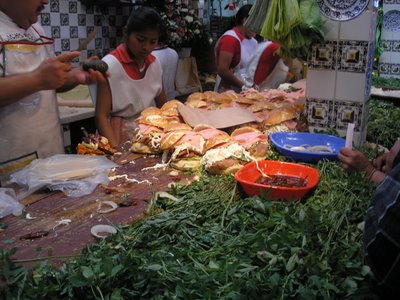 A cemita consists of avocado slices, pulled/shredded cheese called panela (similar to mozzarella), chipotles marinated in adobo sauce, and some kind of sliced ham or beef milenesa. It takes a whole bunch of workers to crank out enough cemitas to satisfy the demand. And, at less than $2 each for a sandwich built for two or three, why wouldn't they be popular?
A cemita consists of avocado slices, pulled/shredded cheese called panela (similar to mozzarella), chipotles marinated in adobo sauce, and some kind of sliced ham or beef milenesa. It takes a whole bunch of workers to crank out enough cemitas to satisfy the demand. And, at less than $2 each for a sandwich built for two or three, why wouldn't they be popular?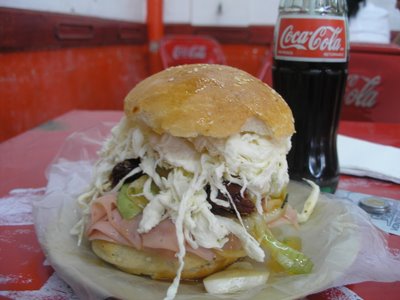 This is the monster cemita that we ordered. We opted for sliced ham because we didn't really understand what the other options were. I'd say it measured about 6-7 inches high and 5 inches across. Pardon the product placement, but I like a little familiarity with my new experiences.
This is the monster cemita that we ordered. We opted for sliced ham because we didn't really understand what the other options were. I'd say it measured about 6-7 inches high and 5 inches across. Pardon the product placement, but I like a little familiarity with my new experiences.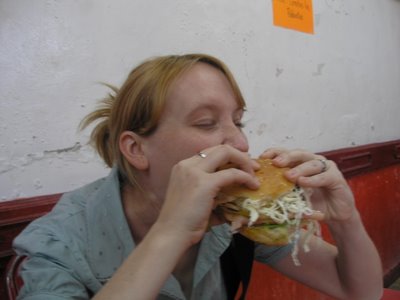 After watching the natives' technique, Karen squeezes one end of the cemita into her mouth and is instantly pleased with the sensations: crunchy bread, chewy cheese, creamy avocados, spicy peppers, salty slices of meat. Between the two of us, we couldn't finish it.
After watching the natives' technique, Karen squeezes one end of the cemita into her mouth and is instantly pleased with the sensations: crunchy bread, chewy cheese, creamy avocados, spicy peppers, salty slices of meat. Between the two of us, we couldn't finish it.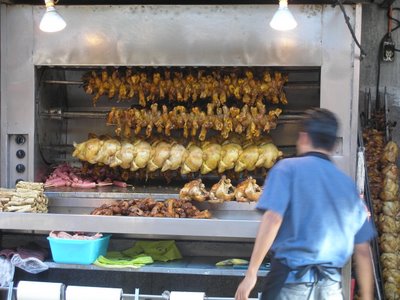 Our walking tour of Puebla continued for miles. And we have non-food related pictures to prove it. The same goes for our last few days in Mexico City, in Coyaocan at Frida Kahlo's house, and walking among the coffee bushes and waterfalls of Xico. And then there's Andrew, my adorable nephew. However, those stories and images will have to wait for the next posting. To make matters worse, I am now taking an online graduate course as I've been accepted into VCU's Masters of Public Administration program. So, I will only be staring at that this machine when I absolutely have to. Thanks for tuning in.
Our walking tour of Puebla continued for miles. And we have non-food related pictures to prove it. The same goes for our last few days in Mexico City, in Coyaocan at Frida Kahlo's house, and walking among the coffee bushes and waterfalls of Xico. And then there's Andrew, my adorable nephew. However, those stories and images will have to wait for the next posting. To make matters worse, I am now taking an online graduate course as I've been accepted into VCU's Masters of Public Administration program. So, I will only be staring at that this machine when I absolutely have to. Thanks for tuning in.
